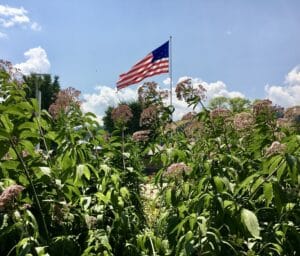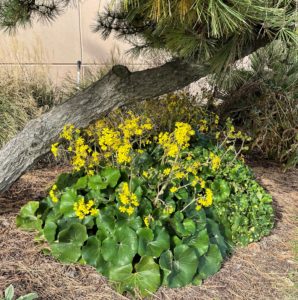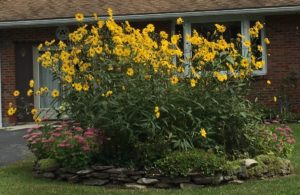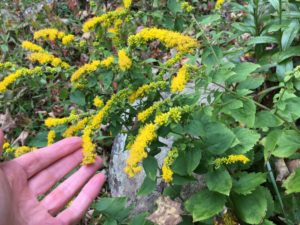Hello, fellow readers. As we approach the homestretch of the gardening season, many gardens grow tired. Mine especially so as the poor things suffer from neglect. Busy tending to other folks’ gardens is my not-so-perfect excuse. Thankfully, there are late-season bloomers I rely on to lift the drab and weedy.

Joe-Pye Weed
Lovlies that Stand Tall
Rising high is Joe Pye Weed (Eupatorium) – a tall native plant seen roadside in full sun or part shade that makes a beautiful backdrop. Eupatorium maculatum’ Gateway,’ commonly sold in nurseries, has volleyball-sized purplish-pink flowers August through September on top of five to seven-foot maroon stems. Some warn they’re prolific spreaders by self-seeding. I prefer to say they’re robust, especially in damp soil; butterflies and hummingbirds love them. There’s E. rugosum ‘Chocolate’ with burgundy foliage that blooms white. Smaller varieties of Joe Pye Weed, such as E. dubium’ Little Joe’, grow about four feet, and ‘Baby Joe’ only slightly over two.
Another deer-resistant late bloomer is Ligularia, also known as Ragwort. Mine is L. dentata’ Britt-Marie Crawford’ with large reddish-brown glossy leaves and orangey-yellow flowers standing about three feet in part shade. She also prefers damp soil and blooms from August through September.

Butterflies love the late-season feast of Ligularia in part shade.

Swamp sunflower, Helianthus angustifolius
Sun lovers
Each fall, I marvel over the Swamp sunflower, Helianthus angustifolius, also called the Narrowleaf sunflower, with yellow daisy-like flowers. It’s on my to-do to plant. Many varieties stand a stately six feet or more, but ‘First Light’ stays about four feet. Swamp sunflower is another moist soil lover that flowers best in full sun, though part sun and well-drained soil is fine with weekly watering.
How about sun lovers like Sneezeweed (Helenium), which looks like small red, yellow, and orange coneflowers? Despite the common name, Sneezeweed doesn’t make you sneeze. The same is true of Goldenrod (Solidago), which has a bad reputation for causing allergies, but it’s Ragweed (Ambrosia) and Mugwort (Artemisia vulgaris) to blame (check out a previous column, Godenrod’s Bad Reputation).
Glorious Goldenrod

‘Golden Fleece’ Goldenrod / Solidago
Some folks believe native Goldenrod is invasive, though authorities don’t think so (Link to story below). Rather than intrusive, think of Goldenrod as opportunistic; you can’t blame the beauty for that. There’s ‘Fireworks,’ which grows three to four feet tall, and ‘Golden Fleece,’ which I have in the rock garden standing a cute eighteen inches. Both are sturdy, non-invasive, and full of brilliant yellow fall blooms. ‘Golden Fleece’ Goldenrod is semi-evergreen and serves as a ground cover effective in squelching weeds when planted in groupings—a beautiful thing.
All the abovementioned late-season bloomers are the perfect additions for weary gardeners looking to pump up fall color in their tired gardens.
Garden dilemmas? Askmarystone@gmail.com and your favorite Podcast App.
There’s much more to the story in the Garden Dilemmas Podcast:



Enjoy reading these entries even though am no gardener yet.
I believe those who enjoy nature or gardeners, even if they don’t garden, are nurturers of our dear earth. And so are indirectly gardeners. But I hope you dig in the dirt someday. You’ll love it! Thank you for reading my post, Mary